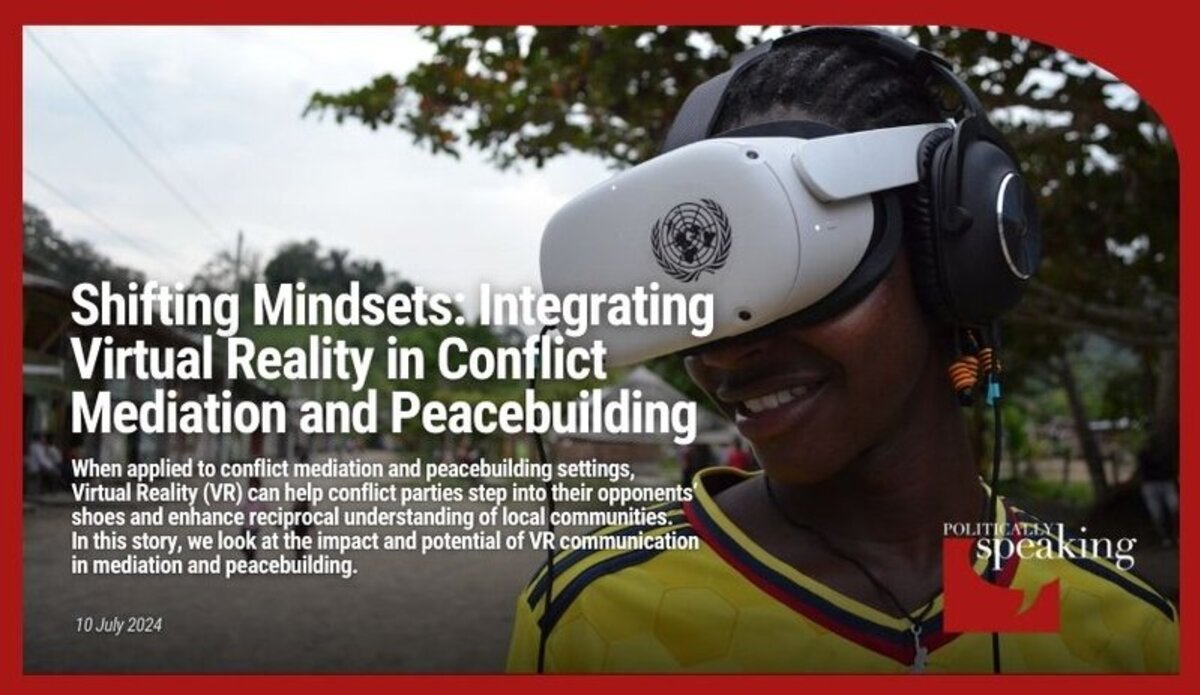When applied to conflict mediation and peacebuilding settings, Virtual Reality (VR) can help conflict parties step into their opponents’ shoes and enhance reciprocal understanding of local communities. In this story, we look at the impact and potential of VR communication in mediation and peacebuilding.
Virtual Reality (VR) is an immersive medium that gives the user the sense of being in a different place or time thanks to computer-generated graphics or 360-degree real-world video footage. In the United Nations, it is being used by those involved in conflict resolution and reconciliation efforts to share perspectives and nurture mutual understanding.
The potential of VR to build sustainable peace
Recognizing the possible value of VR in pursuing peace and security, the Department of Political and Peacebuilding Affairs (DPPA) has integrated the technology into parts of its work. Since 2019, DPPA has produced a series of VR films in collaboration with its special political missions (SPMs). The aim is to get a better understanding of the life of communities affected by conflict and promote engagement among stakeholders.
The 2019 VR series titled Pathways Colombia, for example, showcases, in a personal and empathetic way, the post-conflict reintegration of former combatants as well as justice efforts, with the aim of fostering support for peace processes.
Virtual reality can also be used to simulate possible scenarios for mediators and support decision-making, allowing policy makers to experience situations on the ground with unparalleled immediacy, short of traveling.
“Pathways Colombia was developed with an international audience in mind, to give diplomats in New York and around the world an idea of what it is like to be on the ground in Colombia,” explained Constanza Rubio Garcia, strategic communication officer of the UN Verification Mission in Colombia.
“The response was very positive, as many ambassadors involved in discussing peace and security matters in Colombia had never been to the country,” she added.
Member states support this approach.
“At the German Mission, we made the experience that VR technologies present opportunities to immerse ourselves and our partners in local realities,” Deputy Permanent Representative of Germany to the UN in New York Thomas Zahneisen told Politically Speaking. “This makes them a cost-effective way to help with timely and impactful decision-making.”
Shifting perspectives
One benefit that VR communication tools can introduce in peace processes is shifting mindsets by showing different perspectives to conflict parties, stakeholders and local communities.
“VR has significant potential in supporting perspective taking,” Julie Gregory, a research scientist at the Stimson Center, told Politically Speaking. “Conflict parties in entrenched positions don’t always understand the reality on the ground or the humanitarian consequences of their actions,” she added.
The films produced by DPPA and field missions, for instance, offered insights into Iraq’s post-ISIS transition, allowed stakeholders to virtually engage with Sudanese government officials and activists, explored various aspects of the Colombian peace process, and showcased life in Lebanon.
“While we are aware that new technologies such as virtual reality cannot replace interaction between people, we are convinced that they can be powerful tools to advance storytelling, show other realities, generate empathy, combat stigmatization and hopefully generate commitment to peace,” Rubio Garcia said.
Measuring the impact of VR communication
While research points to numerous potential benefits of VR technology in conflict mediation and peacebuilding, its application remains limited, making it difficult to fully grasp its efficacy.
To measure the impact of VR versus non-VR advocacy, the UN Verification Mission in Colombia, together with DPPA’s Innovation Cell, recently conducted a study with 1200 students, dividing participants into groups exposed to either VR or non-VR communication inputs, both UN and non-UN related.
The study found that VR has a similar effect in terms of memory recall as other traditional multimedia interventions, in comparison to pure text-based communication products. However, much more than two-dimensional documentaries, virtual reality gives the opportunity to virtually walk through each other’s journeys, helping build empathy with others.
A cautious approach
While highlighting the advantages of VR tools, experts also point to the need for caution. Trust, understanding, confidentiality and consent are key in the use of VR by conflict mediators. Moreover, using such tools requires a degree of technical expertise and significant investments.
And experts cite another crucial consideration. “It is vital to lead with authenticity, ensuring that the narrative is compelling and true to the experiences it seeks to convey,” Martin Waehlisch from DPPA’s Innovation Cell said, adding that it is important to steer clear of sensationalism. “The story must remain at the forefront, engaging and resonating with the audience on a personal level.” For DPPA, working closely with local partners is therefore essential.
As VR develops, collecting more data will be essential to fully grasp and measure its impact on peace and security work. “Using new technologies in peace processes needs to be meaningful and not just a gimmick,” Waehlisch said.


